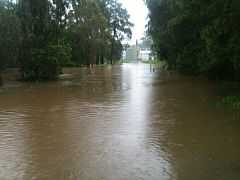Pomona, Queensland
| Pomona Sunshine Coast, Queensland | |||||||||||||
|---|---|---|---|---|---|---|---|---|---|---|---|---|---|
|
Pomona Hotel | |||||||||||||
| Population | 2,587 (2011 census)[1] | ||||||||||||
| Established | 1890 | ||||||||||||
| Postcode(s) | 4568 | ||||||||||||
| Location | 30 km (19 mi) W of Noosa Heads | ||||||||||||
| LGA(s) | Shire of Noosa | ||||||||||||
| State electorate(s) | Gympie | ||||||||||||
| Federal Division(s) | Wide Bay | ||||||||||||
| |||||||||||||
Coordinates: 26°21′47″S 152°51′22″E / 26.363°S 152.856°E
Pomona is a town located at the base of Mount Cooroora at the northern end of the Sunshine Coast, Queensland, Australia. The town was originally called Pinbarren Siding and was renamed Pomona in 1906, after the Roman goddess of fruit and orchards. Pomona is 140 kilometres north of Brisbane, and approximately 30 minutes driving time from Noosa Heads. It is within the local government area of Shire of Noosa (between 2008 and 2013 it was within Sunshine Coast Region).
History

Pomona was first settled by Europeans in the late 1880s, but had been home to the Gubbi Gubbi indigenous peoples for thousands of years before that. Pomona is the historic heart of the Noosa Biosphere. Declared by the United Nations Economic, Scientific and Cultural Organization (UNESCO), World Biosphere Reserves are learning communities that cultivate harmony between people and nature in support of conservation and sustainable development.
Early settlers collected timber from the area.[2] The railway to Pomona was operating in 1891, opening the land to farming.[2]
Pomona State School was established on 31 August 1897, originally located in Stan Topper Park until 1976. The school is now located on Station Street. (Town streets were named after the functions of buildings located along them - thus the street names include Ambulance St, Church St, School St, Factory St, and so on.)
The town became the administrative centre of the Noosa Shire Council in 1909 until 1 December 1985 when the Council moved to its Tewantin premises. The original headquarters for the Shire were constructed in Pomona in 1911 on a site now used (since 1985) by the Cooroora Historical Society and Noosa Museum. The main street of the town was devastated by fires in 1939 and 1942.[2] Many buildings were re-constructed with brick or in the "Art Deco" architectural style of the era. Colonial buildings are also a feature of the town and can be viewed along a signed historic walk.
The Noosa Trail Network of walking tracks through the surrounding forests, farmlands and villages is popular with visitors, but especially every October when the Great Noosa Trail Walk is held. Visitors may also walk to the top of Mount Cooroora, the solidified lava plug of an ancient volcano worn away over time. Every July, thousands of people cheer 100 runners who race to the top of the mountain and back in under 30 minutes in the annual King of the Mountain event. Those not fit enough to race up the mountain can participate in the world thong throwing championships (thongs of the footwear variety) with the rules stating that a size 10 thong, or larger, must be used. The record throw is 42.8 meters.
The district's rural roots are celebrated every September with the staging of the annual "show" (county fair). The Noosa Country Show has been a local institution since 1909. The early colonial dairy industry at Pomona was replaced by a patchwork of small cropping farms. Some produce edible goods for South-East Asia markets. Local food and craft markets are held every second week. The largest employer in Pomona is Pages Furniture Factory. In 2016, a new export dairy plant will open nearby, restoring dairying as a mainstay of the local economy.
Pomona has a town population of about 2,500 and a district population encompassing a further 4,500. It has freeway and passenger rail links to the inner-Sunshine Coast and to Brisbane, the state capital of Queensland.
Heritage listings
Pomona has a number of heritage-listed sites, including:
- 3 Factory Street: Majestic Theatre, Pomona[3]
- 29 Factory Street: Noosa Museum[4]
- Red Street: Pomona Police residence (& former station), lock-up and courthouse[5]
- 9 Station Street: Cooroora Masonic Temple (former)[6]
Attractions
Pomona is notable for three things: a relaxed streetscape of distinctive timber and art deco buildings, the heritage-listed Majestic Theatre and the annual King of the Mountain race[7]up the nearby, Mount Cooroora. The Majestic, built in 1921, is claimed to be the world's oldest continuously operating silent movie theatre built for that purpose. However, it is not the first theatre in the world in which silent films were screened. The Majestic has been a community-owned enterprise since October 2006.
Australian musician Darren Hanlon's album "Fingertips and Mountaintops" was entirely recorded in the Majestic Theatre.
See also
- Pomona railway station, Queensland
- List of twin towns and sister cities in Oceania
References
- ↑ Australian Bureau of Statistics (31 October 2012). "Pomona (L) (Urban Centre/Locality)". 2011 Census QuickStats. Retrieved 18 September 2012.
- ↑ 2.0 2.1 2.2 Environmental Protection Agency (Queensland) (2000). Heritage Trails of the Great South East. State of Queensland. p. 144. ISBN 0-7345-1008-X.
- ↑ "Majestic Theatre (entry 30257)". Queensland Heritage Register. Queensland Heritage Council. Retrieved 14 July 2013.
- ↑ Cooroora Historical Society. "Cooroora Historical Society - Noosa Museum". Spiderweb. Retrieved 23 July 2013.
- ↑ "Pomona Police residence (& former station), lock-up and courthouse (entry 19636)". Queensland Heritage Register. Queensland Heritage Council. Retrieved 14 July 2013.
- ↑ "Cooroora Masonic Temple (former) (entry 19543)". Queensland Heritage Register. Queensland Heritage Council. Retrieved 14 July 2013.
- ↑ http://kingofthemountain.com.au/
External links
![]() Media related to Pomona, Queensland at Wikimedia Commons
Media related to Pomona, Queensland at Wikimedia Commons